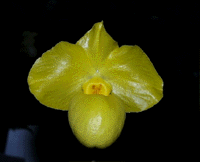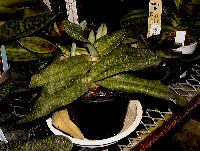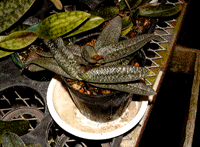|
| In a group of genus Paphiopedilum and subgenus Parvisepalum, we have Paph. delenatii, Paph. armeniacum, Paph. micranthum, Paph. emersonii and Paph. malipoense and furthermore Paph. jackii, Paph. hiepii, Paph. vietnamense, and Paph. hangianum that are discovered newly in these days. Before, we know Paph. delenatii only and it is in the same group, subgenus Brachypetalum like Paph. bellatulum, nivium etc. But it was so easy to identify that Paph. delenatii is very different from other members in the subgenus Brachypetalum. But when Paph. armeniacum and micranthum was discovered newly in China, Paph delenatii was one of the members in the new subgenus, Parvisepalum including Paph. armeniacum and micranthum by Dr. Karasawa and Saitoh. In the new species of the new subgenus, the species are very different from other species in Paphiopedilum and stand out prominently in the color and shape of their flower. We use the special feature of these species for the new breeding and the hybrids come into fashion in these days. On this stage, not only the new species but also Paph. delenatii that we know are going to use for the new breeding. |
A request |
Although I 'll introduce about the species of Parvisepalum and how to culture, you have another information and/or experience to grow in your condition. There is a big difference between us taht might be dependent on the climate. Please send any information from your experience. I want to introduce yours on this site. Thank you |
1)The distribution and the culture of Parvisepalum |
 |
@The species of Parvisepalum are distributed widely in the Indochinese Peninsula, from the central-East ( Viet Nam ) to the North-West ( China, Yunnan ).Before we consider how to grow them, it is very important to know the climate of the area. |
| @Now, we divide 3 areas for understanding the
climate for each species. (1)The northwest area, in China, the central north of Yunnan for Pap. armeniacum. (2)The middle area, in China, from Guizhou plateau to the north area in Viet Nam for Paph. micranthum, emersonii and malipoense. (3)The central east area in the Indochinese Peninsula, Viet Nam for Paph. delenatii. |
(1)The northwest area, in China, the central north of Yunnan₯₯₯₯₯Paph. armeniacum |
Paph. armeniacum |
 |
| @In the south of Yunnan about 27 ,the north latitude, they have Rankan River that is the the upper stream of Mekon River to Viet Nam and Salween and Nue River. It is about 600 ~1,000 meters above sea level. In this area, it is the subtropical zones basically and we don't need Jacket in the lower area but we need in the higher area. Around here, they prepare the specific ground by lime stone and Paph. armeniacum like these area near by Beajun in Yunrin mountains. Paph. armeniacum grow in the depression and crevice of lime stone. In this area, they have high temperature and moisture of monsoon from Indian see in may and it continue to be cloudy and strong rain sometimes. To September, it is in rainy season. By the rain, each river is flood. Although they are in the subtropical zones, it is very cool in summer because it is high above sea level. The max. tem. is about 28 and the min. tem. is about 13 . In winter, the very cold and dry monsoon come from the Chinese continental. But it continued to be fine days and they have very heavy fog from the evening to morning. Paph. armeniacum like the area where they never get the cold monsoon and semi-bright. By the shade of trees and rocks, they don't get the sun shine directly but it is very bright because by reflective light. The flower will be made by the coldness in winter and bright sun shine in winter. The flower will be com from Dec. to Feb. usually. The special colony about 100 km distance from Salween river is made up by the plants who have no purple-red pigments, antocian. Someone says these clone are album form but we had better to call them flavum. |
| Simple cultivation
of Paph. armeniacum @In the nature, Paph. armeniacum grow in the severe climate. But it grow well in better condition like green house. But for flowering, it need some natural spur like temperature and/or sunshine. For growing plants, the temperature as the min. will be better from P0~13 in winter. The shield should be about 50 % for a whole year. As they don't like food too much, be careful to give fertilizer too much. You had better give fertilizer from March to July when it is the growing period. And you had better use liquid fertilizer diluted from twice to 5th times more than regular dilution instead of solid fertilizer for the beginners especially. As a compost, they don't like sphagnum moss. The mix compost is the best and/or crypt-moss or bark only. In good condition, they will make a few young plants from one matured plan. But don't cut them sooner. Keep then for one year at least when they will have roots their own. For flowering, they need cooler , bellow 15, around 10 or bellow 10 is the best I guess for artificial culture, temperature from the late of fall to winter. And in the same time, they need the sun shine enough. When it is fine, you keep the plants under sun shine as long as possible. They like water very much. In nature, we have the impression they grow in dry condition but we never dry the compost in winter from my experience. I prepare a plate under the pot and put water in the plate for winter season. I don't dry the water in the plate. |

